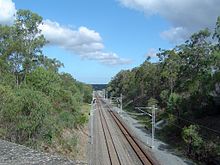Gold Coast railway line, Brisbane
| Gold Coast line | |||
|---|---|---|---|

Railway south of Ormeau station, 2014
|
|||
| Overview | |||
| Type | Commuter rail | ||
| System | Queensland Rail City network | ||
| Status | Operational | ||
| Locale | Gold Coast | ||
| Termini |
Domestic Airport Varsity Lakes |
||
| Stations | 20 | ||
| Operation | |||
| Opened | 1996 | ||
| Owner | QR | ||
| Operator(s) | QR | ||
| Technical | |||
| Track gauge | 1,067 mm (3 ft 6 in) | ||
|
|||
The Gold Coast railway line is an interurban railway line operated by Queensland Rail in Queensland, Australia, connecting Brisbane with the Gold Coast. This line carries the biggest inter-city commuter traffic in Australia with 26,000 workers commuting each day to Brisbane.
The Beenleigh railway line opened in 1885 before being extended as the South Coast Line to Southport in 1889. A branch line to Tweed Heads, New South Wales was opened in 1903 with excursion trains traveling the line on 10 August 1903 and the first passenger train making the journey from Brisbane on 14 September 1903. Due to the increasing popularity of the motor car, and political interests in road transport, the Tweed Heads branch closed in 1961 and the line from Beenleigh to Southport closed in 1964.
The new Gold Coast railway opened on a different alignment from Beenleigh to Helensvale in 1996, Nerang in 1997, and Robina in 1998. In 2009, the line was extended to Varsity Lakes. There are plans to eventually extend to Elanora, before reaching all the way to Coolangatta.
The Gold Coast (Varsity Lakes) railway line is an extension of the Beenleigh line. Trains travel express between Park Road and Beenleigh stations, with limited stops (currently at Altandi and Loganlea) on the Beenleigh railway line. Most trains from the Gold Coast run through to Brisbane Airport, allowing tourists and locals access to more international destinations than from the Gold Coast's own airport.
...
Wikipedia

